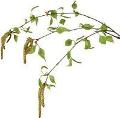Use of material is possible with active link
© 2015 - 2024. Hunting, Fishing - Information Portal Support the project, donate
Tips for a duck hunter
Duck scarecrows can be exposed directly from the shore, regardless of the depth, relief and hardness of the bottom of the reservoir, even in the absence of a boat. How is this done?
My method is simple and built on the principle of a conveyor. The whole device consists of a load (anchor), a ring, a cord, a pin with a ring, stuffed animals with leashes. We pass the cord through the anchor ring, align both ends in parallel, preventing twisting, then we pass one of the ends through the pin ring and tie them so that the knot easily passes through the anchor and pin rings.
Having chosen the place of hunting, we securely stick the pin and throw the load a little further than the place where the stuffed animals should be exposed. Then we check the free movement of the cord through the rings of the anchor and pin. This rope conveyor between the anchor ring and the pin ring is used to move the stuffed animals to the right place.
Tying the leash of one stuffed animal to the cord and putting it on the water, we smoothly pull the free side of the cord over ourselves. Then we tie the second scarecrow, tighten the cord again, etc. So you can put any number of stuffed animals in the intended place. At the end of the hunt, the winding is done in reverse order; you can pull both ends of the cord at the same time, together with the anchor.
For the successful and rapid development of this method of staging stuffed animals, it is useful to take note of some tips.
The first (and indispensable) condition is careful preparation of all equipment at home and preliminary training: knitting knots, laying out stuffed animals, picking and throwing cargo.
Each stuffed animal should have a reliable loop under the goiter, for which the leash is attached. For better stability of the stuffed animals on the water, a counterweight is attached to them. It can be made from a lead plate of 80-100 g in the form of a washer, which is attached with a patch of raw rubber and an auto vulcanizer in the center of the effigy, behind the loop.
For each stuffed animal, we fasten a 70-100 cm long leash from a strong nylon thread with a diameter of 0.8-1.0 mm for a loop under the goiter; so that it does not get confused during transportation, it is wound around the neck of the stuffed animal, and the loop made at the end of the leash is put on the nose of the stuffed animal. At both ends of the leashes, loops of 5-6 cm in size are tied with a special knot .
To transport the stuffed animals, it is necessary to sew a special bag made of dense fabric. We start packing in the bag in the reverse order, since the stuffed animals placed on top should be the first when exposed.
A load packed with a cord ring and a pin is placed on the effigies. The anchor cargo is best made from lead waste. Its weight is 800-1200 g, depending on the number of stuffed animals exhibited. We pour lead into a tin can. Before pouring lead in the side wall of the jar, at a level of 5 mm from the bottom, drill two holes with a diameter of 5 mm. We prepare two wires in advance with a length of 45 cm, with a cross section of 2-2.5 mm. The outer ring is made of brass or steel wire with a cross section of 4-5 mm. The four ends of the wire are wound into both holes of the jar so that the ring does not reach the jar by 10-15 mm. Inside the jar, we dilute the wire in the middle part by 20-30 mm. Before pouring lead, the prepared jar must be thoroughly dried, since water droplets accidentally found in it when pouring lead instantly turn into steam, which can throw molten lead out of the jar.
To ensure the average weight of a 1 kg jar, it is necessary to pour lead 10 mm from the bottom. After pouring, the top of the jar is cut off according to the lead level with an allowance of 3-5 mm; the allowance is bent, the free ends of the wire are cut off, leaving them 8-10 cm long, and symmetrically spread in four directions. To protect against corrosion, the cargo must be painted with oil paint in any soft color.
It is necessary to throw the cargo at a distance of 30-35 m, and put the stuffed animals much closer, since ducks in most cases sit behind the stuffed animals. However, sometimes it is necessary to throw the load further. In this case, it is useful to use the casting method of spinning. To do this, a strong stick with a length of 120-150 cm and a ring stop is taken. After a little training, a load weighing 1 kg is freely thrown by this technique at 45 - 50 m.
If there are loops on the leashes, the scarecrows can be grouped in single file, parallel or tabun. At the same time, it is necessary to simply and securely tie the leashes to the cord so that the leash knot does not move along it and, most importantly, does not spontaneously untie.

Video - Duck hunt in the spring:
